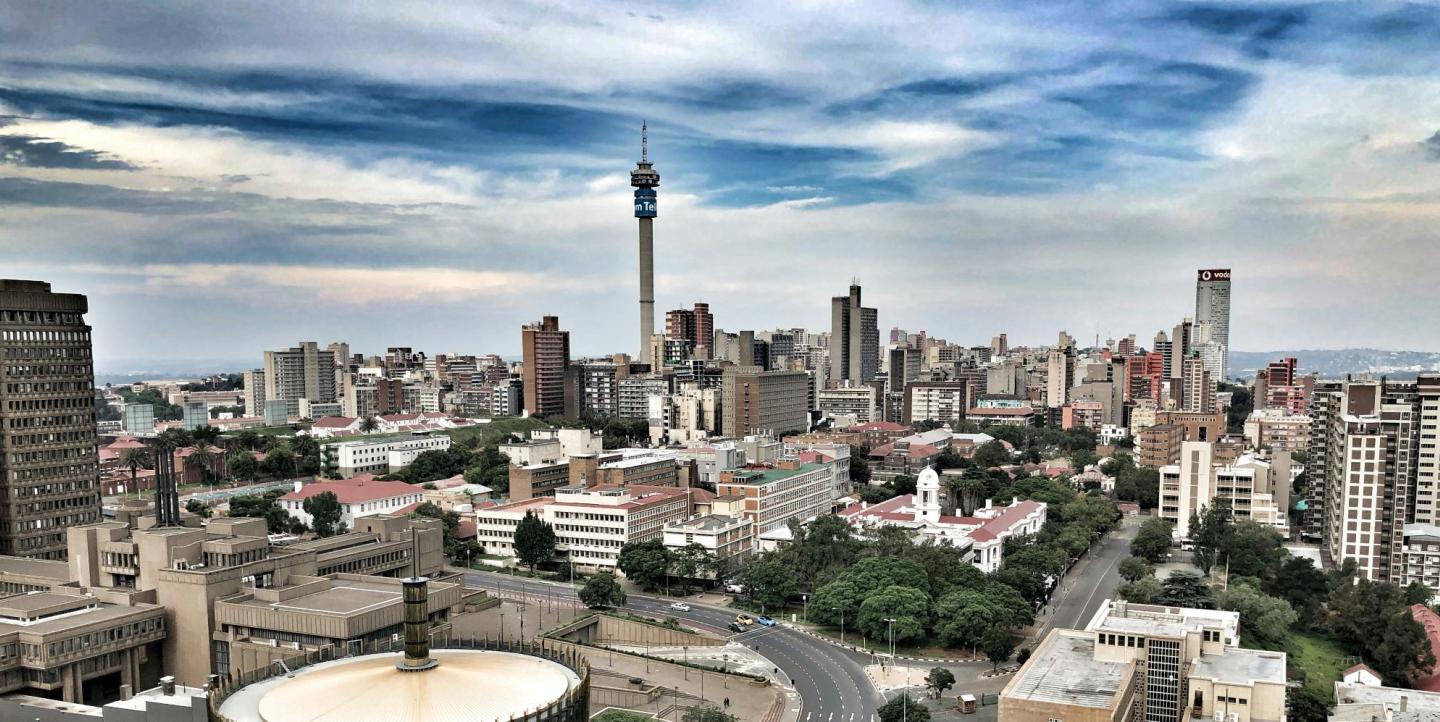Content warning: This report includes graphic content that illustrates the severity of online violence against women, including references to sexual violence and gendered profanities. This content is not included gratuitously. It is essential to enable the analysis of the types, methods and patterns of attacks against the South African women journalists of Daily Maverick.
On the eve of South Africa’s presidential election, new research from ICFJ in partnership with the University of Sheffield details how online attacks against women journalists in the country are perpetrated routinely and with impunity.
The attacks, infused with misogyny, racism or homophobia, among other forms of discrimination, seek to sideline journalists and silence their critical reporting. Meanwhile, law enforcement authorities and the Big Tech platforms on which the violence occurs provide little to no recourse, and too few newsrooms offer mental health support for the women targeted.
Inflicted by populist political actors and their followers, co-opted media, anti-vaxxers and more, the attacks tend to spike in the aftermath of critical reporting – and rise closer to elections.
“Any woman journalist in South Africa who publishes investigative work on, for example, State corruption or the actions of populist political party the Economic Freedom Fighters (EFF) and its leaders, becomes a potential target for online violence,” write the report’s authors, Dr. Julie Posetti, deputy vice president and global director of research at ICFJ, Julie Reid, professor at the University of South Africa, Nabeelah Shabbir, deputy director of research at ICFJ, and Dr. Diana Maynard, senior research fellow at the University of Sheffield.
Amid high levels of gender-based violence in South Africa, and a rise in assassinations of whistleblowers and investigators in recent years, “the potential for online violence to translate into physical violence is high,” warn the researchers.
Together with partners at The Nerve digital forensics lab, the researchers analyzed more than 180,000 tweets relating to their main case, Ferial Haffajee, a former editor-in-chief of South Africa’s Mail & Guardian and City Press, and currently a reporter and associate editor at the independent investigative newsroom, Daily Maverick. Haffajee’s experience as the target of online violence is considered “nationally emblematic,” the report notes.
The researchers also examined over 90,000 tweets relating to Pauli van Wyk, and qualitatively assessed abuse directed at Rebecca Davis, both women journalists with the Daily Maverick.
The report is the latest in a series of big data case studies demonstrating alarming patterns of online violence with offline consequences for women journalists globally.
Scope of the violence
X (formerly Twitter) has served as the primary social media platform on which online attacks are perpetrated in South Africa, explain the researchers. Violence also spreads on WhatsApp, Facebook and Telegram.
Of the tweets analyzed by researchers, more than half directed at Haffajee (60%) and van Wyk (54%) were personal in nature; just less than half sought to discredit them professionally (40% and 46%, respectively).
Roughly one in five tweets targeting the journalists was “sexist, misogynistic or sexualized.” In general, the attacks tend to be “highly sexualized,” at times referencing acts of extreme sexual violence: being “shot in the pussy,” for instance.
The research subjects came under fire especially when reporting on corruption involving major political parties and actors.
A coordinated disinformation campaign carried out by the now-defunct British public relations firm, Bell Pottinger, to discredit journalists’ reporting as part of the 2013-2016 #Guptaleaks investigations into political corruption has served as a playbook on how to harass women journalists on Twitter, the researchers found.
During the online violence campaign, the PR firm created fake social media profiles to attack critics and peddle false, hate-filled information, by utilizing “astroturfing” among other strategies. The perpetrators honed in on Haffajee, making her the primary target of “highly sexualized and misogynistic” abuse in what was the first large-scale coordinated Twitter campaign against a woman journalist in the country.
The perpetrators
Political actors, co-opted journalists, anti-vaxxers and conspiracy theorists have been among the primary perpetrators of online violence. They have used legitimate accounts, fake bot armies and automated accounts to carry out attacks.
The ruling African National Congress (ANC) party and the populist Economic Freedom Fighters (EFF) – South Africa’s third largest political party – have attacked women journalists in retaliation for exposing corruption and fraud in their ranks.
The EFF, in particular, has singled out women journalists, doxxing and physically threatening them. They “have become the country’s leading army of cyber-violence as it executes an information war,” said Haffajee in 2019. “For years, the EFF has used social media and its rallies to execute a campaign of violence and hate speech against journalists whose reporting it does not approve of.”
For her critical reporting of EFF leader Julius Malema in 2018, van Wyk became the target of “a torrent of online violence.” Malema called van Wyk “Satan” and EFF supporters called for her to be raped and killed. The EFF is “probably the most vicious” center of online attacks against women journalists, Daily Maverick Editor-in-Chief Branko Brkic told the researchers, adding that they “behave toward journalists literally like the Taliban.”
Media outlets aligned with the government or powerful business actors, operating with a veneer of legitimacy as established news sites, have similarly contributed to the online violence. Independent Media, which owns some of South Africa’s oldest newspapers, has “probably been the greatest locus of attacks,” said Davis. She further warned: “The ease with which this kind of trolling has transcended the boundaries of social media into supposedly mainstream media is a real concern.”
During the COVID-19 pandemic, women journalists also experienced higher levels of online violence at the hands of anti-vaxxers and conspiracy theorists. “It was the health and science journalists who really experienced it badly any time they put out information that a certain group of epidemiologists or anti-vaccine proponents didn't write,” said Haffajee.
The Pandemics Data and Analytics (PANDA), a private sector research group trafficking in anti-vaccination conspiracy theories, was the chief perpetrator. “The PANDA group has earmarked me as some kind of persona non grata,” said Davis, recalling a “torrent of vitriolic tweets” she received after co-authoring a report critical of the group. “Their pushback was unlike anything I've received in my journalistic career thus far.”
Context and consequences
The online attacks against women journalists in South Africa occur against a backdrop of “horrific levels of sexual violence.”
More than half of women in the country say they have experienced gender-based violence, according to the World Health Organization, and over three in four men say they have perpetrated such attacks at one time. Every three months, nearly 900 women are murdered, another 1,400 are targets of attempted murder, and more than 10,000 women and children are raped.
Since 2020, there has also been a “sharp increase” in the assassination of whistle-blowers and investigators in South Africa.
This context inflames the threat profile of online violence, explain the researchers. “When women journalists receive rape and death threats via social media, such threats are not perceived to be ‘online only’ or remote threats; they are a very legitimate danger to the journalist and they are perceived as such,” the report reads.
As a result of attacks, women journalists may self-censor and/or assume a lower profile online – consequences the researchers dub the “chilling effect.”
Haffajee acknowledged that she changed reporting beats, and Davis stopped tweeting. Daily Maverick had van Wyk relocate to a remote part of South Africa after she reported on money laundering carried out by EFF’s Malema, and his role in stealing from VBS Mutual Bank. Still others might leave journalism altogether.
Impunity
When journalists are attacked online, they have little to no recourse at hand. Law enforcement in South Africa aren’t familiar enough with the issue, nor do they have the capacity or training to address it effectively. And the social media platforms on which the abuse is carried out don’t treat it with urgency, write the researchers.
Big Tech, in particular, must do more, the journalists stress. “I do think the greatest responsibility does lie with the platforms because they're transnational and they're global and they're enormously powerful [...] This is a global issue that needs to be taken up with the companies,” said Haffajee.
To adequately address the issue would harm the companies’ bottom lines, Brkic argued in a 2020 interview: “Their entire business model would have to change, which obviously they're not going to do. They're going to destroy humanity.”
Contending with the onslaughts of attacks, the journalists also rarely have psychological support made available to them by their newsrooms. “The kind of mental health support for journalists is horrific,” said Davis. “It's just non-existent considering the kind of trauma that journalists are routinely exposed to.”
It’s a familiar story, as previously laid out in countries across Asia and the Middle East, Europe and Latin America: women journalists contend with heightened levels of hate-filled, disinformation-laced attacks due to their reporting – and they have almost nowhere to turn for support.
The full report can be found here.
Photo by Clodagh Da Paixao on Unsplash.


